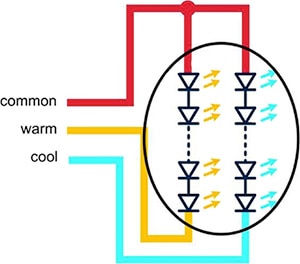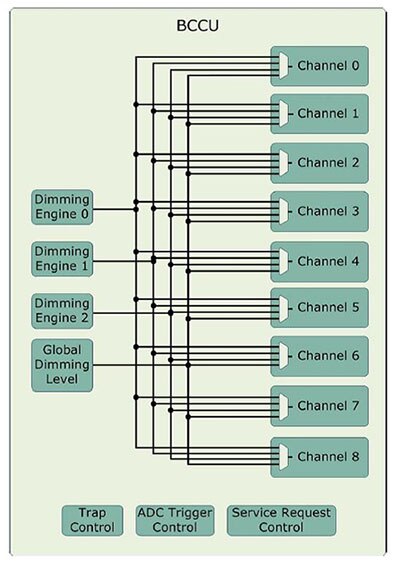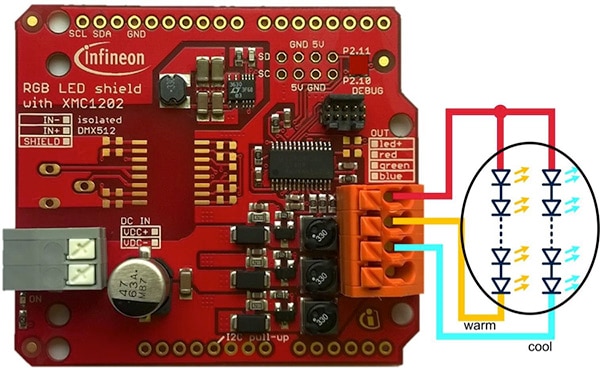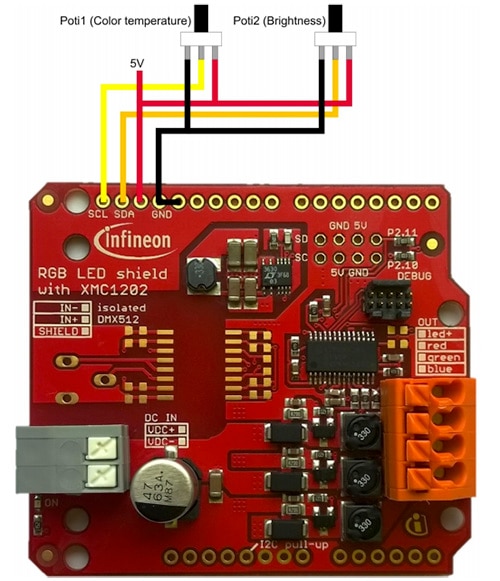Controlling Tunable White LEDs for Human-Centric Lighting
資料提供者:DigiKey 北美編輯群
2017-05-02
As LED lighting systems mature, it is no longer sufficient to simply provide adequate brightness without glare. With research showing clearly that ambient light affects human biology, attention has now shifted to controlling the light source to affect human circadian rhythm, visual acuity, and even productivity.
At the core of this human-centric lighting (HCL) is the tunable white LED. However, for design engineers to implement HCL it is essential they develop circuits that dim the LED, detect and change Kelvin temperature settings, and still manage to deliver the necessary luminance output.
This article will describe HCL and its applications, and then introduce Infineon Technologies’ Arduino-compatible XMC1202 RGB LED Lighting Shield. It will then discuss how the shield can be used for evaluating or making fast prototypes of luminaires for tunable white LED applications.
The light effect
HCL relies upon tunable, high-power LEDs and microcontrollers to mimic the changes of natural light during the day. In the morning, light has a reddish color temperature of around 3000 K. By noon it might be 6500 K. In humans, this color temperature change affects the production of several hormones, including melatonin, that play a key role in the human sleep cycle. Melatonin concentrations are higher at night and lower during the day.
The eyes also gather light information, in particular the amount of ambient blue light. Specifically, the eyes’ intrinsically photosensitive retinal ganglion cells (ipRGCs) are sensitive to a narrow range of blue light at around 480 nm. Studies have shown that light with a high spectral blue component can activate and increase human performance and concentration. If this blue component in light decreases, the body relaxes and changes over to a calmer, albeit less productive mode.
In the past, the choice of color temperature was fixed once an incandescent or fluorescent fixture was selected. If a legacy 3500 K lamp was specified, only 3500 K could be delivered. However, LEDs can be engineered to produce a wide spectrum of visible light, allowing them to be used to artificially match changes in natural light. This can be accomplished via tunable white LEDs using drivers, light engines, and controllable channels to adjust the color temperature of the luminaire's white light output.
In its most basic form, a tunable white LED consists of two LED channels, a cool white channel and a warm white channel (Figure 1). The control parameters are brightness and color temperature. These are typically controlled via a dimmer switch, where the dimming information is carried in the voltage waveform and delivered current. While simple, this approach may not have the dimming resolution or smoothness of a control system based on DALI or DMX protocols, which will be discussed later.

Figure 1: Tuning a white LED requires two channels: warm white and cool white. The control parameters are brightness and color temperature. These are typically controlled using a dimmer switch or simple potentiometer. (Image source: Infineon Technologies)
The challenge of producing light with variable color temperature
For engineers, the HCL design challenge includes the fact that the correlated color temperature (CCT) of solid-state lighting (SSL) changes noticeably with variances in voltage. This led to digital dimming techniques based on pulse-width modulation (PWM). This is popular because the ‘on’ part of the pulse cycle drives the LED at the specified forward voltage, thereby maintaining the CCT. At the same time, by altering the duty cycle, the average current can be changed so as to increase or decrease the LED’s luminosity.
A complicating factor for HCL is that the color temperature also depends on the efficiency of the LED, and there can be efficacy differences between warm and cool white LEDs. Further, color temperature variables can be traced to differences in mechanical design that include heat dissipation, housing, pc board design, and heatsinking.
While complicated, engineers not specifically trained in SSL can develop HCL systems in a straightforward manner using development tools such as the Infineon XMC1202 RGB LED Lighting Shield board (Figure 2).

Figure 2: Infineon’s XMC1202 RGB LED Shield simplifies the design and evaluation of tunable white LED luminaires. (Image source: Infineon Technologies)
The shield uses an ARM® Cortex®-M-based XMC1202 32-bit industrial MCU with an embedded Brightness Color Control Unit (BCCU). It has been designed to provide options for the evaluation of smooth, eye-friendly dimming and color mixing for different topologies. It is also easily configurable and combinable for different LED light engines and lamps for fast prototyping.
For powering the LEDs, the shield uses a DC/DC buck topology and is able to drive up to three LED channels with constant current. There are 10 basic sets of I2C commands that can be sent to the shield to control the connected LED lamp with various lighting effects.
The BCCU provides color control with 12-bit precision. Color transitions can be immediate or gradual by means of a linear “walk”. A linear walker in the LED channel changes intensity linearly over time, and offers a configurable color transition time. For smooth color change, the linear walk time must be the same in all channels, and linear walks must be started simultaneously on all channels.
The shield communicates with a master board via the I2C protocol as a slave. Either an Arduino Uno R3 or Infineon’s XMC1100 Boot Kit can be used as the master board.
The combination of the Arduino board and code on the XMC1202 can control a lamp from warm white, with a color temperature of 2700 K, to cool white, with a color temperature of 5700 K, in 4095 discrete steps. It can also dim the intensity of light in 4095 discrete steps with flicker-free, high-quality light down to a 0.5% dimming level.
In the shield, a sigma-delta modulator converts 12-bit brightness values to a bit stream to form a pulse-density modulated (PDM) signal. Automatic linear intensity changes make brightness or color changes appear smooth and natural to the human eye. To achieve this, selected channels continuously change their intensity for a predetermined duration with the respective targets being reached at the same time, resulting in a straight transition in the orthogonal (CIE Lab) color space.
The primary function of the BCCU is to provide automatic dimming signals on port pins for the external LED drivers (Figure 3).

The Infineon BCCU can dim up to 9 independent LED channels depending on MCU pin availability. It has 3 dimming engines (DE) and a connection matrix connecting them to each other. (Image source: Infineon Technologies)
Two trigger signals can start the analog-to-digital conversions needed to make noise-free measurements on the LED channels (TRIG). The dimming signals can also be routed to CCU4 or CCU8, which can directly drive the LED current control circuitry (OUT). The trap state occurs when there is an external emergency such as a short circuit. This information can be routed to the BCCU directly. During TRAP, the BCCU outputs immediately go to a predetermined safe passive level. The output of the analog comparators can be used as an asynchronous gating signal to BCCU channels for fast control loops (IN).
Two out of the three available MOSFET gate drive outputs are used to drive a tunable white LED lamp (Figure 4).

Figure 4: The Infineon shield drives the white tunable LED via buck-topology DC/DC converters. (Image source: Infineon Technologies)
Interface choices and programming aids
A DMX512 interface can be used in place of a dimmer switch to control the tunable white LEDs. DMX512 is commonly used to control stage lighting and theatrical effects. DMX512-A is the current standard and is maintained by ESTA (Entertainment Services and Technology Association). The DMX512 signal is a set of 512 separate intensity levels (channels) that are constantly updated. One DMX link of 512 channels is defined as a Universe. Typical theatrical consoles have multiple Universe outputs.
XMC1000 products such as the XMC1202 can also be used as Digital Addressable Lighting Interface (DALI) slaves. DALI is a non-proprietary two-wire bi-directional interface standard for dimmable electronic control. It has a high degree of flexibility, allowing for control either individually or in a broadcast mode for up to 16 groups without the need for a relay. Switching and dimming are handled via the control line, and important information such as the lamp status is stored and is available to the controller. DALI can address up to 64 LED units on its single two-wire interface.
Even if different lighting systems start at different dimming values, or different types of lamps are combined with each other, DALI synchronizes the changes from one lighting scene to another. This means that all the light sources reach the new light value at the same time to provide consistent lighting for HCL systems.
Version 4 of DAVE™, Infineon’s development platform for XMC MCUs, is available for standard lighting communication protocols. DAVE is a free Eclipse-based integrated development environment (IDE) including GNU C-compiler, debugger, comprehensive code repository, hardware resource management, and code generation plug-in. A complete download package is provided including APPs, examples, and DAVE SDK. Using DAVE, engineers can configure the LED color change system and peripheral clocks as well as configure the BCCU global, channels and dimming engine.
Implementing HCL
The Arduino shield and the XMC1202 can be used with control potentiometers to implement an HCL system. This application uses five lines from the board and two out of the three available MOSFET gate drive outputs, for a simple and cost-effective evaluation of tunable LEDs.
Two potentiometers are employed: one to control brightness and another to control color temperature. This requires two analog-to-digital converter (ADC) channels, P2.10 and P2.11 (Figure 5). These were previously reserved for I2C communications (SDA and SCL respectively). The pull up resistors connected to the SCL and SDA pins must be removed to prevent crosstalk.

Figure 5: Illustration of XMC1202 connections to potentiometers to effect control brightness and color temperature. (Image source: Infineon Technologies)
To connect to the potentiometers, five Arduino pins, located on the top right of the board, are used (Figure 6).

Figure 6: The potentiometers are connected to five pins on the top left of the Arduino board: SCL, SDA, 5 volts dc, and two grounds. (Image source: Infineon Technologies).
Conclusion
The application of HCL to control light levels and color to meet human needs is the next stage in the evolution of lighting and luminaire design. At its core is the tunable white LED. For design engineers to implement HCL it is essential they develop circuits that not only dim, but also detect and change Kelvin temperature settings while delivering the necessary luminance output.

聲明:各作者及/或論壇參與者於本網站所發表之意見、理念和觀點,概不反映 DigiKey 的意見、理念和觀點,亦非 DigiKey 的正式原則。






